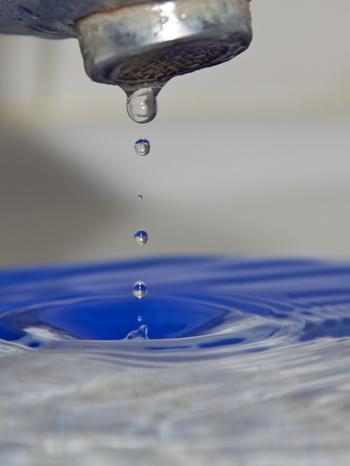Attitude change
Dripping tap
Image Credit: Ximeg, 2012 http://commons.wikimedia.org/wiki/File:Water_drops_by_Ximeg_24.12.12-02.jpg
One example for water savings: Attitude change.
- If you brush your teeth twice a day, for 3 minutes each time, and leave the tap running while you're brushing, you'd use around 5 litres per minutes. That's 10,950 litres per year, per person!
➜ Use a glass of water to rinse your mouth after brushing. You could save 9,100 litres per year, per person. - Most "older style" shower heads use 20 litres of water, or more, per minute. So if you have a 7 minute shower, that's 50,000 litres per year.
➜ Install a modern shower head. It uses only 9 litres per minute. That's a 45% boost in its efficiency which could save 28,000 litres per year, per person.
➜ Shower instead of a full bath and stop water while using soap to stop the water flow => saves up to 40 l per washing cycle. - A leaking toilet can waste up to 16,000 litres of water per year.
➜ Check if your toilet is leaking by putting a little food colouring in the cistern. If the colouring begins appearing in the bowl even without flushing, get the cistern repaired immediately.
➜ Replacing your single flush toilet with a 6/3 Dual Flush toilet can save up to 7 litres of water per full flush. In a home with 2 adults and 2 children, that can amount to a saving of 36,180 litres per year. - A running tap can use between 15 and 200 litres of water each minute.
➜ Wash your fruit and vegies in a kitchen sink half filled with water (about 12 litres). If your washing takes around 3-5 minutes, you'll save 33 to 48 litres of water. - You can use 35 litres of water each time you use a dishwasher. So it is definitely worth following the manufacturer's instructions to ensure you maximise its water efficiency.
➜ Don't rinse dishes before loading them into your dishwasher. Use the "Rinse & Hold" setting, instead. Also, do your dishwashing at night and save by using "off peak" electricity. - You can use 120 litres of water, or more, each time you use your washing machine. So make sure you adjust the water level to suit your wash load.
➜ Don't use your washing machine for one or two garments. Ensure you have a full load.
➜ When buying a new washing machine, choose one that is water efficient. You could save a substantial amount of water, as well as money, over the life of the machine. - Watering your garden during the heat of the day is wasteful because much of the water will evaporate before it even reaches the roots. In fact, watering the leaves at this time can actually damage them.
➜ Water your garden in the cool of the morning or late evening, when your plants can get the maximum benefit from the water you give them. Frequent watering makes your plants shallow rooted and more dependent on you for survival.
➜ Water your garden less often, but more thoroughly. This encourages your plants to extend their roots deeper, making them hardier, and less thirsty.
➜ Installing "micro sprays" for annuals and ferns will ensure that water is efficiently controlled at a rate the soil can absorb, avoiding wasteful water runoff. You can save time. You save water. And your garden flourishes. Clever landscaping can save up to 50% of the water you use in your garden. - If you wash your car once a fortnight and leave the hose running throughout, you'd use 1,000 litres of water per hour. That's 13,000 litres per year.
➜ Limit the use of your hose to a quick spray at the beginning, to loosen the dirt and grime, and at the end to rinse off the soapy water. You'll save around 400 litres per wash. Even better, wash your car on the lawn and "water" it at the same time.
➜ Car can be washed at a car washing plant with recycling water - Rehabilitate leaking pipes (e.g. garden connection).

